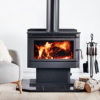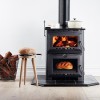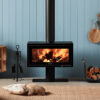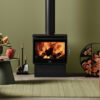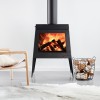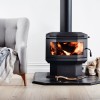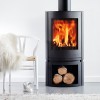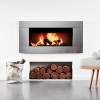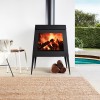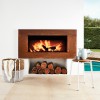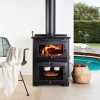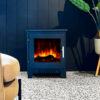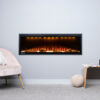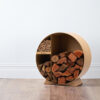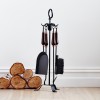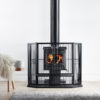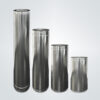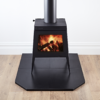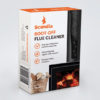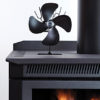Fire Based Heating
Are wood fires good for the environment?
When you purchase a Scandia wood fire you can be confident in the knowledge that you are purchasing the only sustainable and most affordable renewable source of home heating available.
As a supporter and sponsor of Landcare Australia we are mindful of any impact on the environment, so it’s reassuring to us to know that 98% of hardwood burnt in Australia is sustainably sourced and by choosing to burn this firewood in a Scandia wood fire you will generate no additional CO₂ emissions than if that same wood was left to rot naturally in the bush.
To control the amount of emissions released into the environment Scandia design all their wood fire appliances with a two-stage primary and secondary air system, the latter of which hyper heats any excess carbon during the secondary burn phase, converting the majority of residual emissions into energy which is stored in the firebricks and firebox improving overall efficiency of the heater and minimising any impact on the environment.
As an organisation Scandia are committed to helping the environment through the promotion of renewable energy, sustainable harvesting practices and a commitment to programs that focus on reducing carbon emissions.
However, like all things there is a “but”; older style wood stoves were not manufactured to the same rigid specifications and can be very inefficient. In many cases old stoves can use twice as much fuel to produce the same amount of heat as a Scandia combustion heater which is why it is important to replace any wood fire manufactured before 1999 with a modern variant.
Convection or Radiant - Which one?
When selecting a wood fire the decision requires a number of considerations but in essence the decision to go with either a convection or radiant wood fire in the main comes down to personal preference, the following is a brief outline of the differences and the considerations you may want to give when making your choice.
Convection Heat – Convection is simply the tendency of a substance, which in the case of wood heaters is air, to rise when it is warmer as it is less dense because it contains less moisture and fall as it cools resulting in the transfer of heat. Convection wood fires leverage this natural phenomenon to provide a very consistent, controllable ambient warmth throughout the home.
Scandia convection heaters are each fitted as standard with a three speed electric fan which draws cool air in from the bottom of the room and circulates it between the outside of the firebox and outer casing of the wood heater gently warming it before expelling it back into the room where it rises to the roof pushing cooler air down where it is again drawn into the heater and the process begins again.
The heat from a convection heater is often considered gentler and more even than that of a radiant wood fire and with a number of layers around the firebox little hands are less likely to be burn if they inadvertently come in contact with the top or sides of the wood fire.
Radiant Heat – When considering a radiant heater it is prudent to understand that the external surface on the wood fire is actually the outer skin of the firebox which “radiates” heat to warm objects around the fire, the closer in proximity to the fire the warmer the object, which is why radiant heaters are great for both indoors and outdoors and preferred by those who like to “feel” the fire whilst watching the flames.
Another thing to consider when purchasing a radiant wood fire is the increased requirement for clearances to combustible items. Often the mistake is made to buy a small radiant for a small room when space is limited, in fact in many instances it is better to install a mid-size convection wood fire with reduced clearance requirements when space is at a premium.
To achieve natural convection with a radiant wood fire we suggest leaving open a number of doors within the dwelling to promote natural air flow and a more consistent and comfortable warmth to radiate throughout the home. Ceiling fans also offer another means of promoting convection within the home as does the installation of a heat transfer system which extracts the heat from the room where the fireplace is located and re-distributes it through the house via ducts in the wall or ceiling.
What are the benefits of firebricks?
Firebricks are integral factor in the efficiency of the Scandia wood fire appliances. Firebricks act as an additional layer of insulation and store the energy produced by the fire. A firebrick lined firebox also maximises overnight burn times and optimises the life of the firebox.
Replacement firebricks are very affordable and should be changed on an as required basis.
Are all flue kits the same?
Not all flues are equal and an incorrectly installed or poor quality flue can significantly impact the performance of any wood heater. Scandia wood fire appliances are independently tested for emissions, efficiency and thermal clearances using the relevant Scandia flue kit. To ensure you get the best possible performance, we recommend all Scandia wood fire appliances be installed using the recommended Scandia Default Flue Kit and any required extensions.
How do I stop smoke coming in to the room when I open the fireplace door to add more wood?
All enclosed wood fires release a little smoke when the door to their enclosure is opened. To minimise this, we suggest opening the door slightly for a few seconds. Doing so creates increased draught in the flue which will draw the majority of gas and smoke out of the firebox and up the flue.
Wood fires with bay windows are renowned for releasing small amounts of smoke into a room, this is because smoke accumulates in the protruding section of the bay window and requires greater draught to extract it from the firebox.
Following the aforementioned procedure will minimise instances of this occurring but will never stop it completely as this is just a characteristic of bay window models.
My new wood fireplace is smoking and smells like paint, is this normal?
During the curing process of your new fireplace you may experience some smoke and a smell emanating from the painted surfaces during the first few fires. This is a normal part of the curing process.
To help reduce this, begin by lighting a small fire and progressively build the fire unit it is well alight at this point reduce the amount of airflow until the fire is burning at a moderate rate allowing the fire to continue to burn until out and completely cool before lighting again.
Repeat this process building the intensity of the fire each time for a total of 5 fires before reverting to a pattern of regular use.
How do I light my fire?
Establishing a good fire requires a really good platform to start with and there are many schools of thought on how best to achieve this. But the one thing that is unanimous is the fact that you must have good quality, dry kindling to start a fire with. Here’s how the team at Scandia likes to light a fire…
You will need:
- Matches
- Firelighters & newspaper
- 8 to 12 pieces of dry kindling
- 3-4 Small-Medium Logs
- 2 Large Logs
Check that the air slide on your fireplace is in the maximum open position. Open the door and place lightly crumpled newspaper on the bottom of the firebox, placing a firelighter in the middle. **Never use petrol, kerosene or any other accelerant fuels.**
Loosely stack small kindling in a cross hatch pattern on top of the newspaper leaving at least 1 cm in between pieces to ensure there is adequate air flow.
Light the paper with the door open watching as the fire becomes fully involved. Once the kindling is full alight, add a number of small-medium sized logs (about the size of your fist), close the door with the air slide still fully open and allow these to establish a good coal base before adding larger logs in a front to rear direction.
*Be careful, logs placed left to right direction are able to roll forward towards the door.
Continue to leave the air slide in the full open position for at least 20 minutes in order to allow the fire to establish and the larger logs to become fully involved.
The glass on my wood fire appliance is black, what can I do?
The blackening of the glass on your wood fire appliance is the build-up of soot, largely from the smokey creosote of uncured firewood.
The first course of action to alleviate this is to increase the intensity of the fire by opening the air slide on your appliance to maximum for a short period of time which should burn-off most residual particles. If this fails to rectify the situation we’ve got a couple of options available to you
First, you can grab some Scandia Heavy Duty Glass Cleaner and a set of Scandia Glass Cleaning Pads. These will do the trick.
Second, and to minimise the build-up of soot on the glass, only burn good quality seasoned hardwood that has had time to completely dry out. Poor quality wood with a high moisture content is the single largest contributing factor when it comes to the build-up of soot and creosote.
How do I go about choosing the best firewood?
You should only use sustainably sourced, dry, seasoned hardwood in a Scandia wood fire appliance. Sustainably sourced firewood varies from state-to-state: in Victoria, New South Wales and South Australia – Red Gum is a preferred and the most prolific species of sustainably sourced firewood. In Western Australia it’s Jarrah and Wandoo. In Tasmania, it’s Brown Peppermint and in Queensland, Ironbark and Box are the preferred species.
The best choice of firewood also depends on the intended use. Red Gum is excellent in a slow combustion heater but does not burn with a lot of flame, however for an open-flame fire one might choose a species that burns at a higher rate with a larger flame.
Some species that are known to not burn well at all include Cypress, Turpentine and White Stringybark.
Each species has its own characteristics of burning rate, flame, coal and ash generation, which mainly relate to wood density and the chemical composition of the tannins and how dry the wood is. Perhaps the best thing to do is to try a range of the available species and pick the most suitable, which may be a mix of quicker and slower burning species.
*It’s important to note that any wood that hasn’t been adequately dried and seasoned will cause a build-up of creosote in the flue and sometimes on the glass of closed fireplaces, which can impede the performance of your fireplace and degrade it over time. So always try to order your firewood a season in advance so that it is good to go!
Why should I replace my old open fire?
Everyone loves an open fire but the reality is they are inefficient, plagued with excessive fuel consumption and uncontrollable heat levels sending much of the energy produced straight up the chimney as carbon emissions.
Scandia’s series 3 range of inbuilt wood fires are an ideal and sustainable solution for existing homes with an open fire seeking a cleaner, warmer, more sustainable solution.
Optional floor mount fascia’s are available for the Warmbrite range of inbuilt wood fires which when installed are proven to significantly reduce carbon emissions and firewood costs by converting any existing open fireplace into an efficient, temperature controlled and environmentally friendly combustion heating solution.
I like the look of an in-built wood fire but I don’t have a brick chimney.
Scandia’s series 3 range of inbuilt wood fires are an ideal and sustainable solution for the new home builders or renovator looking for the warmth, ambience and style of an inbuilt wood fire but not wanting to build or don’t have a masonry chimney.
The 200i-S3 & 300i-S3 are supplied as standard with a mid-mount fascia, which when combined with one our zero clearance kit can be installed into a timber stud wall as the perfect wood fire solution for homes up to 30 squares.
Scandia are one of the few manufacturers that offer a zero clearance option for their entire range of in-built wood fires.
Why doesn’t the air slide on my heater shut down completely?
The Australian standard 4012/13 currently required particulate emissions (pm2.5) produced by a wood fire to be less than 2.5g per kg. In 2019 this measure is to be reduced further to reflect a maximum 1.5g per kg.
To reduce emissions a fire must burn hotter, this means adding oxygen to the fire. The factory adjusted gap in the primary air slide is pre-defined to ensure that every Scandia appliance conforms to the Australian Standard for Emissions and efficiency.
To control the amount of emissions released into the environment Scandia design all their combustion wood fires with a two stage air system:
- Primary air (controllable by adjusting the air slide) is the mechanism by which the user controls warmth.
- Secondary air (Fixed) hyper heats any excess carbon during the secondary burn phase, converting the majority of residual emissions into energy which is stored in the firebricks and firebox improving overall efficiency of the heater and minimising any impact on the environment.
Can I purchase my heater / accessories / spare parts from Scandia?
As the manufacturer, we operate solely through the Bunnings Network, and our products are available for purchase at your local Bunnings Store.
Can Scandia send someone to install / service our new appliance?
Scandia cannot install appliances. Scandia is the manufacturer and supplier of the appliances. Installation should only be completed by a suitably qualified trades person:
Only engage suitably qualified and experienced tradespersons to complete any solid fuel (wood) or gas appliance installation – regulations vary so check with your local and state authorities. Examples of qualified trades would be roof plumbers/gas plumbers/qualified appliance installers.
Suitably qualified trades will ensure the safe and compliant installation of the appliance ensuring that the appliance is installed as per the manufacturers specifications and in accordance with AS/NZS 2918:2018 Domestic Solid Fuel Burning Appliances – installations for solid fuel appliances (wood) and AS/NZS 5601.1:2013 Gas Installations – General Installations for gas appliances.
Can I install my wood heater myself?
Unfortunately, no. Wood-fire heaters and fireplaces require a qualified professional to install them whose work conforms with local council regulations, Australian Standards & manufacturers recommendations. It is a requirement that all Scandia solid fuel and gas appliances are fitted by a qualified, licensed installer whose work complies with local council regulations, Australian standards, and manufacturer’s specifications. Failure to correctly install is extremely dangerous, will void any warranty claims and may compromise any future insurance claims.
I need to make a warranty claim for my heater, how do I do this?
Our aftersales team can help with appliance troubleshooting and issue support, send an email to [email protected] and be sure to include the following details to assist us in resolving your issue promptly.
- Proof of Purchase
- Serial number
- Details of the issue

